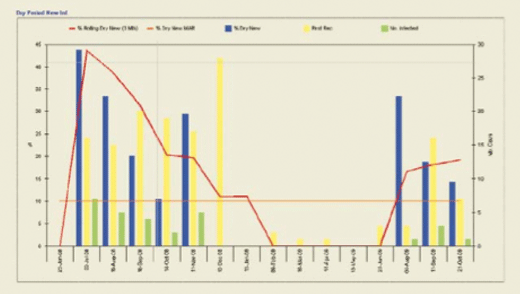



Mastitis Guide: Monitoring Udder Health
The impact of any management changes need to be monitored. There are many ways that udder health can be monitored, but the key aim is to use whatever information is available to help identify when and where animals are picking up new infections, says the sixth part of this essential mastitis guide produced by Pfizer Animal Health UK.Somatic cell count analysis
Ideally, individual cow somatic cell count (ICSCC) should be analysed on a regular basis using herd management software.

In the absence of ICSCC there are still simple, cost-effective ways of measuring the impact of any management changes.
Clinical mastitis analysis
As for subclinical mastitis, the timing of clinical mastitis cases can help to identify the source of infection. Mastitis cases within the first 30 days of lactation are likely to be due to infections acquired in the dry period, whereas those occurring after 30 days in milk are likely to have their origin in lactation. Accurate mastitis and calving records are all that is required. Once again, herd management software can analyse this information, but simple manual recording systems can also be valuable.
Why do I need to know?By identifying whether or not the dry period is important on your farm it is possible to target mastitis control measures to ensure the highest possible return on any investment in udder health.
How can I identify that the dry period is important?Research has clearly demonstrated the link between infection during the dry period and subsequent clinical mastitis and elevated somatic cell count (SCC) in early lactation.
How can I find out if the dry period is important on my farm?Use some simple charts (like those illustrated on the next page) to determine the importance of the dry period on your farm instructions on how to use these are provided.
Do I really need to do this for clinical and subclinical mastitis?Yes – it is important to look at both types of mastitis as the usefulness of cell counts or clinical mastitis will vary according to the pathogens on your farm.
What are the targets and how do I decide if I need to improve?Outlined overleaf are the targets and reasoning for both clinical and subclinical mastitis.
Monitoring clinical mastitis


If less than 1 in 12 cows develop clinical mastitis in the first 30 days of lactation and less than 1 in 10 cows have an elevated SCC at their first milk recording then your herd is performing well in terms of dry period management and is on target for optimising udder health.
If more than 1 in 12, but less than 3 in 12 cows develop clinical
mastitis in the first 30 days of lactation and less than 3 in 10 cows have an elevated SCC at their first milk recording then addressing dry period issues in your herd is likely to improve mastitis control - at this level there is a significant risk that the mastitis situation in the herd could rapidly
If more than 3 in 12 cows develop clinical mastitis in the first 30 days of lactation and more than 3 in 10 cows have elevated SCC at their first milk recording then with respect to the dry period the mastitis situation is out of control. There is an urgent need to address dry period issues in order to minimise/reduce the risk of further deterioration of the mastitis situation on the farm.
The routine collection and submission of milk samples from both clinical cases as well as high cell count cows can help to build up a picture of which pathogens are contributing to udder health problems in any particular herd. A good knowledge of the pathogen picture on a farm can help farmers target specific areas of management. For example, repeated evidence of contagious bacteria such as Staphylococcus aureus would indicate that control measures such as post-milking teat disinfection, milking order and herd segregation, amongst others, should be considered.
November 2012

